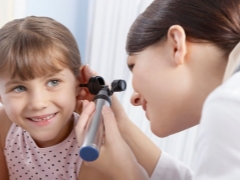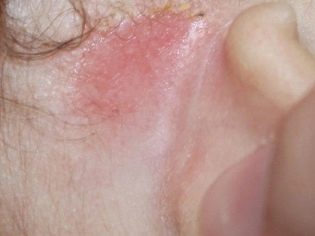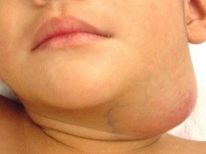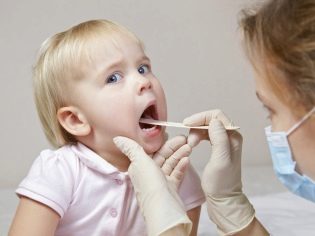Symptoms and treatment of scrofula behind the ears in children
Such a concept as scrofulls today is more common in fairy tales and fiction than in medical documents. However, sometimes, when a child looks unimportant, the grandmothers no, no, and they will say that he resembles a scrofulous one. About what scrofula is and how to be, if it appeared in the child behind the ears, we will tell in this article.
What it is?
Zolotuha is a type of exudative diathesis and a disease of tubercular origin. The disease was described in the XII century. Then it was considered deadly, and he was treated, to put it mildly, outside the box - the patient was offered to attach himself to Catholic shrines. At about the same time, the rulers of the French royal Capetian dynasty treated this disease by laying hands on the patient. At the same time, they said that the king’s touch gives God the opportunity to heal.
In this mysterious way, scrofula was treated massively until the XIX century, and, judging by everything, contrary to logic, it was very successful. Then doctors and scientists became interested in a strange disease, and called it "scrofula." They took as the basis the Latin word “scrofa”, which means “boar”, “boar”, “wild pig”.
The name, of course, is coarse, but fairly accurate, because at the very beginning, the person who became ill began to resemble a boar's snout by enlarging the lymph nodes under the jaw and on the neck. Studying the causes of the disease, the doctors concluded that the disease is caused by mycobacterium tuberculosis, which is directly related to the causative agents of the most basic types of tuberculosis. For example, scrofula is considered to be in this family and is sometimes called tuberculosis of the lymph nodes.
There is a myth among the people that scrofula can lead to tuberculosis. This is not entirely true, since it is already a form of this malady, but it is more similar to the symptoms of exudative diathesis. That is why scrofula is considered the initial stage of this skin disease.
In fact, the situation with scrofula is rather paradoxical - with one name, by and large, there are two completely different diseases, one of which has an undoubted affiliation to tuberculosis, and the second is the usual dermatological-allergic one.
More often than others, both diseases affect children. Most often scrofula-diathesis appears behind the ears. But it happens that it extends to other parts of the body - limbs, torso, neck. Scrofula-scrofula also occurs behind the ears, but has a different clinical picture.
The reasons
Scrofula (tuberculosis) scrofulosis, as we have already found out, causes mycobacterium, which settles and multiplies in the lymph nodes. It is quite common. There are two types of this microbe - human and bovine. Quite often, children become infected in those regions where there are outbreaks of epidemics in animals.
There are numerous external and internal factors that can cause scrofula in the interpretation of a skin disease - exudative diathesis:
- genetic predisposition to allergic reactions;
- allergenic food;
- medication use;
- contact with detergents, household chemicals, natural allergens.
Among other reasons, the involvement of which to the appearance of scrofula, from the point of view of medicine, is a big question, numerous sources indicate:
- violation of the rules of hygiene, if the child is rarely bathed;
- Conception of a baby by parents in a state of alcohol or drugs;
- the birth of a child by elderly parents who in the past had tuberculosis, cancer, or syphilis.
It is rather difficult to refute or confirm these probable causes, since science does not know much about scrofula and the mechanisms of its occurrence.
Symptomatology
Both types of scrofula need treatment. Just therapy will be different. Determine what kind of scrofula in a child is not difficult, because the symptoms are very different from each other:
- From time to time cracks appear in the scabs, from which serous fluid is released, sometimes with blood impurities. Peel off the crusts can and without discharge. In this case, completely smooth pink skin is visible under the crust. Quite often, such scabs behind the ears are accompanied by the appearance of formations similar in appearance to the scalp.
- Additional symptoms may include discharge. from the nose for allergic rhinitis, discharge from the ears, allergic conjunctivitis, swollen lymph nodes. Large folds on the child’s body become inflamed, and so-called diaper rash appears in them. Sometimes cough and allergic swelling of the larynx are added.
- Scrofulous. At the initial stage, a small nodule behind the ear or slightly lower - closer to the neck will appear. Gradually, it increases in size, softens, and one day bursts, releasing purulent and bloody contents. An ulcer or fistula is formed. Other signs are added to this unpleasant picture: the child's skin turns pale, the temperature rises, he sweats a lot and completely refuses to eat, gets tired quickly.
- With scrofulous skin allergies in a child, most often in infants at the age of 3 months, behind the ears there are pockets of dry skin, which are quite itchy. Quickly on the affected areas, scabs are formed, which are called “scrofulous crusts”. They have a white or whitish-yellow color, sometimes with a mixture of gray.
Diagnostics
A pediatrician, a dermatologist, and an allergist can figure out what scruffy has happened. A general blood and urine test is taken from a child, and an immunological blood test is additionally done to determine the fact of an allergic reaction. If it is confirmed, the allergist conducts diagnostic tests for allergies in order to determine what the inadequate reaction of the child is to. Without this, treatment will be ineffective.
Eczema spots behind the ears and on the neck for scrofula require a completely different approach from diagnosticians. The child is swabbed from the pharynx, as well as a sample of secretions on the skin for the detection of mycobacterium tuberculosis. If the diagnosis is confirmed, ultrasound of the lymph nodes is done to determine the extent and "geography" of the lesions.
Treatment
Treatment of scrofula behind the ears will depend on what scrofulous material is found.
Exudative diathesis
The first step is to eliminate the contact with the allergen. If it is installed, it will be easier to do this. But quite often, allergy tests do not show a positive reaction to the most common allergens, and then the cause is considered idiopathic. In this case, parents are advised to eliminate all possible allergens in the house where the baby lives. Hide away or throw away household chemicals, cleaning will have to be carried out without products containing chlorine.
The child’s bedding will need to be replaced with natural fabrics without patterns and textile dyes. The same requirement - for underwear, pajamas, clothes. Wash baby clothes and bedding will only need baby hypoallergenic washing powders, and be sure to rinse with pre-boiled, chlorine-free water.
They will have to “carry out” pets from the apartment, they often cause an allergic reaction in children, as well as eliminate all items that can accumulate ordinary house dust - carpets, soft toys. The child should not sweat, because with sweating, the manifestations of scrofula only increase.
Therefore, the baby needs to wear lightly, not to muffle so that the ear space and head do not sweat. The air temperature in the apartment should not exceed 20 degrees.
During bathing, you can use only boiled water, which does not contain chlorine. Baby soap can be used no more than once a week. All the rest of the time, the baby with scrofula needs to be bathed in plain water.
Parents will have to reconsider the baby's diet - together with the doctor, pick up a new adapted mixture, if it is artificial, or adjust the mother's diet, if the baby eats breast milk. From the diet of children who are already eating from the table, you will need to remove all foods that may be allergenic - cow and goat's milk, nuts, citrus fruits, chicken eggs, honey, spices, red berries.
From drugs to moisten the crust behind the ears use ointment "Bepanten", Children's cream," La Cree ". Sometimes the doctor prescribes zinc ointment. Usually, treatment is stopped with the last crust falling off, if no new ones are formed.
If the crust behind the ears began to "get wet", then it is better to use ointments and creams with a drying effect - «Sudokrem», eg. In rare cases, when scrofula is very pronounced, and the child suffers from tangible suffering, the doctor may prescribe hormonal ointment («Advantan"," Latikort "), as well as antihistamines («Fancarol"," Suprastin ") together with calcium supplements.
Scrofula
After confirming such a diagnosis, the treatment should be started immediately. Treatment will consist of taking anti-TB drugs that are active against mycobacteria. Outwardly on the affected places on the neck and behind the ears impose lotions with an antiseptic, sometimes with ointment with antibiotics.
Sometimes use radio wave treatment and cryotherapy. Without specific drugs can be quite serious complications - eye damage with a decrease in visual function, hearing loss, the development of hearing loss.
Unfortunately, quite often it is necessary to resort to surgical intervention and to remove operatively a part of the affected lymph nodes. After such therapy, the child must be prescribed several courses of sanatorium-resort treatment.
Treat folk remedies such scrofula is strictly prohibited.
Prevention
Certain prophylaxis of any of the varieties of scrofula is not available. There are general recommendations that can reduce the risk of developing pathologies:
- The child must be kept in good sanitary conditions, sleep in clean linen and breathe fresh air.
- You can not overfeed baby, it increases the risk of developing allergic scrofula in the form of diathesis.
- A child’s nutrition must contain all the necessary vitamins and microelements. It is very important that the baby has enough vitamins of group B, vitamin E, C, A.
- If a child has been diagnosed with diathesis, then this condition is not contagious, which cannot be said of scrofula. In the second case, it is necessary to provide the child with isolated treatment, precluding contact with other children in order to avoid the spread of the disease.
- You can’t refuse to conduct a Mantoux test, it almost always allows you to establish the presence of scrofula at the very initial stages and start treatment in time.
- The child should regularly visit the pediatrician. All complaints about the bite or cracks should immediately be addressed to the specialist, going to an unscheduled reception.
All about the proper care of the ears and the prevention of ear diseases in the next issue of the transfer of Dr. Komarovsky.


























